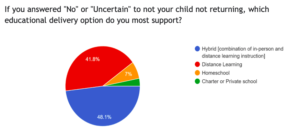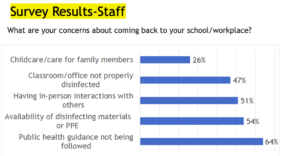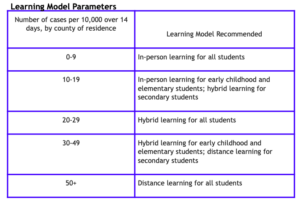Talk of what to do about school this fall has reached a fever pitch in Minnesota recently, as families first waited for Governor Tim Walz’s announcement last Thursday and, now, many await plans from the school districts themselves.
St. Michael-Albertville school district’s superintendent, Dr. Ann-Marie Foucault, presented teaching and learning plans for fall at Monday evening’s school board meeting, which the board approved. The district plans to announce plans for fall on August 21, using Wright County case count data from the 2-week period between Aug. 2-15 to determine the path forward.

Survey Results
Dr. Foucault shared results from both a family survey and staff survey that were given at the end of July. 1,924 people responded to the family survey, and it showed that two-thirds of STMA parents intend to send their children to school in the fall, while just under 30 percent felt unsure and close to four percent do not intend to send their student(s).
Of the families who answered “no” or “uncertain” to the question of whether they intend to send their students, 48 percent said they’d most prefer a hybrid option of distance and in-person learning, while nearly 42 percent preferred distance learning only. Seven percent said they would homeschool, and three percent said they’d choose a charter or private school instead.

Courtesy of STMA School District
Over 70 percent of families said they’d be willing to provide alternate transportation for their students to help the district meet social distancing guidelines on school busses.
On the staff side, over 400 staff members responded, including teachers, paraprofessionals, Kids Play staff, clerical, food service, and others. On a scale of 1 to 5 rating their comfort level returning to school, staff members had very mixed feelings. An even 16 percent felt comfortable with no concerns, a 1 on the scale, and 16 percent answered a 5, meaning not comfortable at all. The most popular response was a 3, with 29 percent of the total responses.

Courtesy of STMA School District
If school resumes on-site in the fall, the survey found that about 77 percent of responding staff said they’d return to their employment on-site, while nearly 20 percent said they’re uncertain at this time. The other three percent said they’d request an accommodation, an extended leave of absence, or resign/retire.
Planning for an Unprecedented Year
Foucault said the district has plans for in-person, hybrid, and distance learning models for the upcoming school year, and she said each individual building may move between any or all of the three scenarios during the 2020-2021 school year.
While a decision on how to start the school year will be based on case counts from the first half of this month, Foucault said that doesn’t mean the district will constantly shift learning models each time new two-week numbers come out. Instead, she said any decision to change the learning model will be made with close coordination among the school district, Minnesota Department of Health, Minnesota Department of Education, and Wright County Public Health.
“If there’s an outbreak, MDH may require us to go to a distance learning model, but MDH officials will investigate and try to continue with the current learning model,” Foucault said. “If it is determined to be isolated to a particular classroom or learning pod, they will most likely quarantine these groups for 14 days, which would involve distance learning.”
If an outbreak occurs in Wright County, MDH will attempt to discern the source of the outbreak. If it’s found that the source has come from a specific business or place of employment unrelated to the schools, this may not impact the school’s learning model, even if the county’s case counts rise.
“The decision will not be taken lightly, as we know that any shift in a learning model will have a substantial impact on students, staff, and families,” she said.
Different Amounts of Classroom Time for Different Ages
The most recent data on Wright County’s case counts put STMA in the category of allowing in-person education five days per week for grades Pre-K through grade 4, and a hybrid of in-person and distance learning for grades 5-12. This may change by the time data is available from Aug. 2-15. Families will have the option to choose distance-learning only for those who do not feel comfortable sending their child(ren) to a school building.

STMA’s standard classroom sizes are physically large enough for a class of 21, plus one teacher, to be in a typical classroom and still be considered at 50 percent capacity of the fire marshal’s code for that space. Foucault said Pre-K through grade 2 class sizes will be within this limit anyways, but third and fourth grade class sizes could be as large as 27 students, depending on how many families choose the full distance learning option. In this case, Foucault said students would spend some of their time in learning pods in other areas of the building, such as the teacher’s lounge, the gymnasium, or the cafeteria, where they would complete lessons with the help of a paraprofessional or a specialist teacher.
The tentative hybrid plan for secondary students would have half of students attend school on Monday/Tuesday and the other half on Thursday/Friday. All secondary students would do distance learning on Wednesdays, which would serve as additional prep time for teachers, as they will simultaneously be teaching distance and in-person curriculum and will need time to prepare lessons in multiple ways, interact with distance learning students, etc. Middle school students would begin at 9 a.m. and high school students at 9:30 a.m. Foucault said administration is working hard to hand-schedule students so siblings at the secondary level can attend school the same days, but she said some high school electives may make that task impossible in certain cases, like if a particular course only has enough interested students to run one section.
Bright Beginnings will continue to offer classes for Pre-K students to all who are registered, with classes split up so that Bright Beginnings teachers take half of a class and early childhood special ed. teachers take the other half, rather than combining as in past years.
Changes to Distance Learning
In regards to distance learning, Foucault said they have learned a lot about ways to improve since it was thrust into their laps last March. She said the district has taken steps to improve distance learning instruction and has taken survey feedback seriously. This year’s distance learning will provide the same rigor as classroom learning for the upcoming school year, rather than a stripped-down version of the curriculum. Students will receive standard grades, not pass/fail.
Foucault said other considerations are being made for a variety of student needs, including special education, students with 504 plans, homeless students, English language learners, and the social, emotional and mental health needs of all students, whose lives have all been impacted greatly by the pandemic.
Next Steps
Next week, school certified and support staff will collaborate to fill in any missing details of fall plans, which will then be released to families on August 12. Also on Aug. 12, Foucault will send a required survey to all families, asking them to state their first trimester plans for each school-age child in their family by August 16.
The school district will receive data on Wright County’s two-week case count from Aug. 2-15 on Aug. 20, and they will announce how STMA will begin the school year on Aug. 21.
Here’s a link to Minnesota’s Safe Learning Plan for 2020-2021.
Here’s a FAQ from the STMA school district, updated Aug. 5.